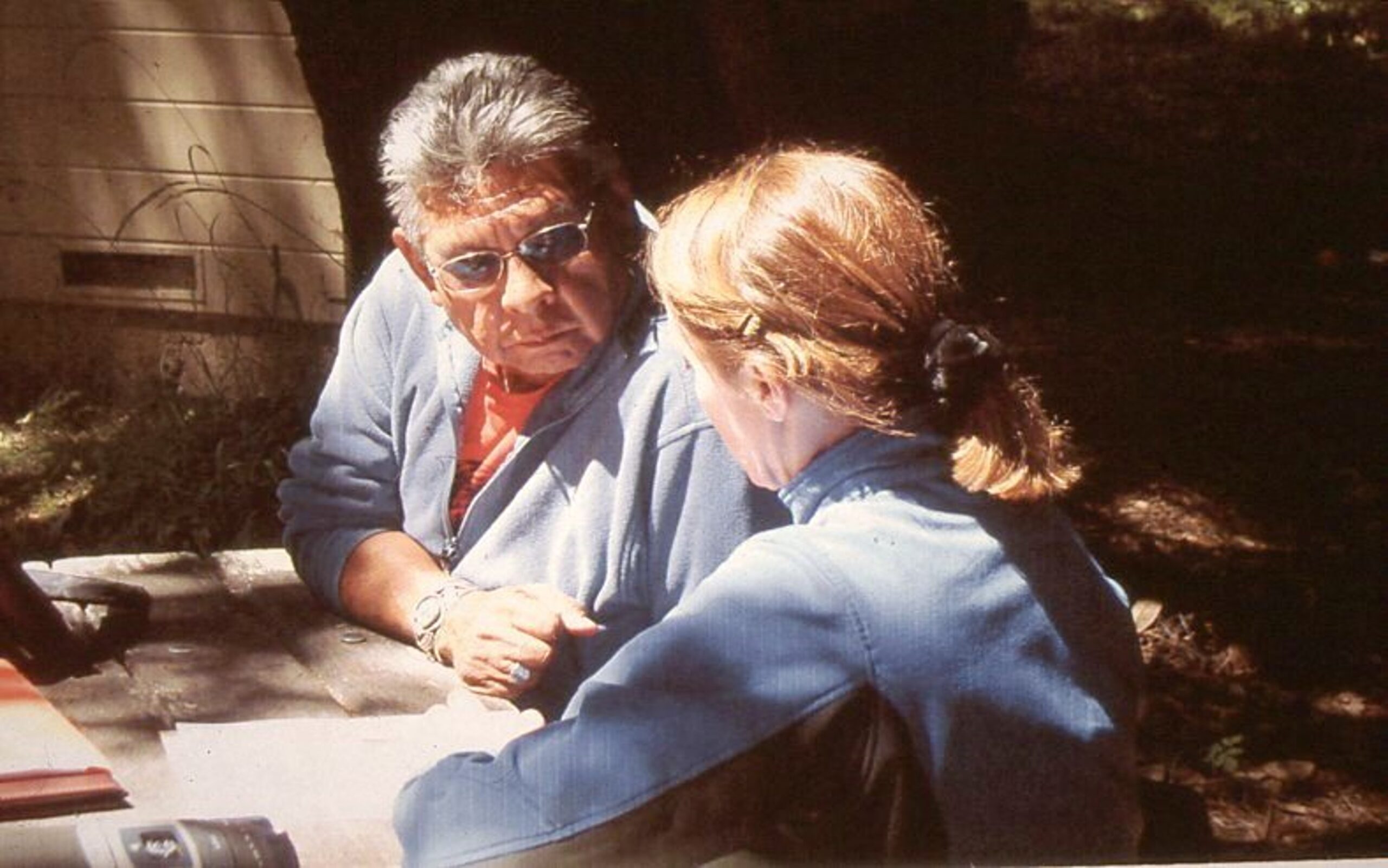Join SCAS for a presentation by Katherine M. Dowdall and Otis Parrish on: “Towards a Socially Just Heritage Management: Tribal Cultural Landscape (TCL) Methods, a Kashaya Pomo Example.”
DATE: Thursday, May 9, 2024
TIME: 7:30 – 8:30 PM (Pacific)
The speakers will present over Zoom, however this is still a hybrid event! We invite you to join us in-person at the Resource Center for Nonviolence, 612 Ocean Street, Santa Cruz, CA 95060, or via Zoom (see below for Zoom registration form)!
ZOOM REGISTRATION FORM: Santa Cruz Archaeological Society (google.com)
***RSVP for Zoom by 6:30 PM on Thursday, May 9, 2024 *** Or show up to the Resource Center for Nonviolence by 7:30 to join us in-person!
Once you have registered for the event using this form, a link and instructions for joining the virtual event via Zoom will be sent to that email address approximately 1 hour before the event starts.
 The presenters have been collaborating for almost 30 years and initially met during consultations between Caltrans and the Kashia[1] Band of Pomo Indians of Stewarts Point Rancheria in the mid-1990s, when Otis was consulting on behalf of his Tribe. He asked Kathy to include Kashaya epistemologies when conducting archaeological studies in Kashaya ancestral territory by using Kashaya heritage protection measures. An example of this earlier work was reported on in A Meaningful Disturbance of the Earth (Dowdall and Parrish 2002).
The presenters have been collaborating for almost 30 years and initially met during consultations between Caltrans and the Kashia[1] Band of Pomo Indians of Stewarts Point Rancheria in the mid-1990s, when Otis was consulting on behalf of his Tribe. He asked Kathy to include Kashaya epistemologies when conducting archaeological studies in Kashaya ancestral territory by using Kashaya heritage protection measures. An example of this earlier work was reported on in A Meaningful Disturbance of the Earth (Dowdall and Parrish 2002).
Over the next two decades, often as volunteers, we developed intensively collaborative decision-making and co-stewardship processes that culminated in The Kashaya Pomo Tribal Landscape Project; Vols. 1&2 (Dowdall, Parrish, Purser, and Wingard 2016). That study content has been previously reported on elsewhere in several professional venues. Over the last decade, there has been a dramatic increase in studies such as ours.
With increasing frequency California Tribes have been initiating the use of TCLs as sovereignty-based heritage stewardship instruments. Access to TCL report content tends to be highly restricted, making it difficult for practitioners to find methodological examples. In this presentation, we try to fill that gap by focusing on the methods and decision-making processes that we used in our TCL study.
 Our methodological framework was Tribally-driven, wide-ranging, cross-disciplinary, and hybridic. As a cross-disciplinary study, our methods were taken from several fields including tribal scholarship, archaeology, ethnography, sociology, and oral history. We will discuss how we used toponomy to define ancestral territory and the Kashaya places in it; the concepts of place-making and memory communities to give Kashaya places their necessary multivalence and multivocality; and our use of place-based oral history interviews and intellectual property rights. We will also discuss how we created Kashaya-derived taxonomies of places and chronologies, a Kashaya-derived heritage questionnaire, and a culturally appropriate heritage management plan. Taken together, we believe that we have developed one example of a robust TCL methodological framework.
Our methodological framework was Tribally-driven, wide-ranging, cross-disciplinary, and hybridic. As a cross-disciplinary study, our methods were taken from several fields including tribal scholarship, archaeology, ethnography, sociology, and oral history. We will discuss how we used toponomy to define ancestral territory and the Kashaya places in it; the concepts of place-making and memory communities to give Kashaya places their necessary multivalence and multivocality; and our use of place-based oral history interviews and intellectual property rights. We will also discuss how we created Kashaya-derived taxonomies of places and chronologies, a Kashaya-derived heritage questionnaire, and a culturally appropriate heritage management plan. Taken together, we believe that we have developed one example of a robust TCL methodological framework.
[1] Kashaya is the phonetic spelling developed by Kashaya tribal scholars and linguist Robert Oswalt (1964) using the American Alphabet System. It is used by Tribal members and cultural scholars when referring to Kashaya culture and the Tribal community. Kashia is the legal spelling of their name – the Kashia Band of Pomo Indians of Stewarts Point Rancheria. It is used by the Tribal Government and all instances when others are working with the Tribal Government or their representatives. This spelling first appears in early 20th century Bureau of Indian Affairs documents.
Otis Parrish, MA, Co-Principal Investigator (Kashia[1] Band of Pomo Indians of Stewarts Point Rancheria) is a Kashaya Tribal and academic scholar. His mother, Essie Parrish, served as the spiritual leader of the Kashaya community for many years until her death in 1979. Numerous anthropologists consulted and collaborated with Essie Parrish. In this spirit, Otis Parrish carried forward parts of his mother’s work by consulting and collaborating as a tribal scholar. Further, he became a professional archaeologist and ethnographer himself. Otis holds a BA in Anthropology from Sonoma State University and an MA in Anthropology from the University of California, Berkeley. Otis has authored and co-authored numerous professional publications including Khela: A Father’s View (Parrish 1976), A Meaningful Disturbance of the Earth (Dowdall and Parrish 2002); California Indians and Their Environment (Lightfoot and Parrish 2009); and The Kashaya Pomo Tribal Landscape Project (Dowdall, Parrish, Purser, and Wingard (2016). Otis currently serves his Tribe as a Cultural Committee Advisor. His views and contributions have greatly expanded the field of California Bay Area anthropology, archaeology, and Tribal heritage preservation.
Katherine M. Dowdall, M.A., RPA, Co-Principal Investigator (California Department of Transportation) is a Senior Archaeologist and District Native American Coordinator in the Office of Environmental Maintenance Caltrans, District 4, Oakland. She has held her position for 33 years. Kathy meets the Secretary of Interior Qualifications for Principal Investigator in archaeology, meets the NPS Professional Qualifications Standards as an ethnographer, and OHA qualifications as an oral historian. Kathy’s original discipline was archaeology, but her education and qualifications later expanded to include ethnography and oral history. Kathy’s publications include Late Holocene Cultural Diversity on the Sonoma Coast (2003); A Meaningful Disturbance of the Earth (Dowdall and Parrish 2002); She is interested in community-based studies, living heritage, inclusivity, and collaborative knowledge production. Using place-based oral histories, she is currently the Principal Investigator of Santa Rosa’s West End Italian Neighborhood Project.
A Meaningful Disturbance of the Earth (Dowdall and Parish 2002)


